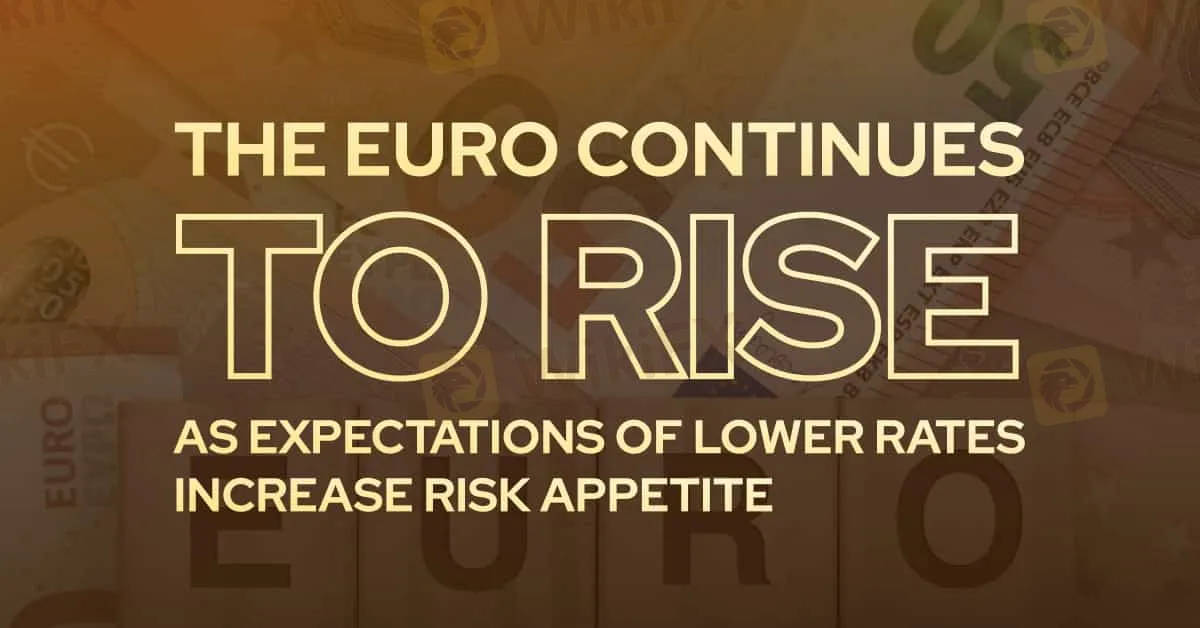简体中文
繁體中文
English
Pусский
日本語
ภาษาไทย
Tiếng Việt
Bahasa Indonesia
Español
हिन्दी
Filippiiniläinen
Français
Deutsch
Português
Türkçe
한국어
العربية
THE EURO CONTINUES TO RISE AS EXPECTATIONS OF LOWER RATES INCREASE RISK APPETITE
Abstract:A weak US dollar and a willingness to take on more risk are driving the Euro higher.

A weak US dollar and a willingness to take on more risk are driving the Euro higher.
Expectations of Fed rate reduction are rising due to a lower outlook for US economic growth and reducing inflation pressures.
Before important Eurozone statistics are revealed, risk appetite may support the Euro in the absence of important data.
After a long Christmas weekend, the Euro (EUR) is trading well during the early US session on Wednesday. With investors applauding the conclusion of the global tightening cycle, which is anticipated to boost economic growth and reduce the likelihood of a severe recession next year, the pair has hit its upper range of 1.1000.
The US government provided data this week that showed how quickly inflation is declining. The Fed's preferred inflation indicator, the Personal Consumption Expenditures Prices Index (PCEPI) dropped to its lowest level in almost three years.
In addition, the previously estimated 5.2% rise in the third quarter of the US Gross Domestic Product was revised down to a 4.9% growth from the same period in the previous year.
These numbers support the soft-landing narrative of slower growth and declining inflation, which heightens expectations that the US Federal Reserve will begin rate cuts in early 2024. This is increasing risk appetite among investors and devaluing the US dollar generally.
Market movers on a daily basis: Expectations of Fed cutbacks are hurting the US dollar
· The Dollar continues to decline on expectations of Fed cutbacks, while the Euro stays stable at four-month highs.
· The US PCE Price Index saw a decrease last week from the downwardly revised 2.9% in October to 2.6% year over year.
· After accounting for the influence of seasonal goods like food and energy, the Core PCE Prices Index decreased less sharply from 3.4% in October to 3.2%. Nevertheless, it was much below the 5.6% high observed in April 2022 and less than the 3.3% predicted.
· When seasonal goods like food and energy are taken out of the picture, the Core PCE Prices Index grows consistently at a rate of 0.2%, dropping from 3.5% to 3.3% over the course of the year.
· These numbers have solidified investors' expectations for early 2024 Fed rate reductions. According to the CME Group FedWatch Tool, futures markets are pricing in more than 70% of a quarter-point rate decrease in March and 150 basis points in 2024.
· With the benchmark 10-year yield at 3.85%, more than 100 basis points below the 5% top attained in late October, US Treasury yields are still falling. The US dollar is under increased pressure as a result of this.
· This week's schedule is light, and the upbeat atmosphere should help the Euro before attention shifts to important
TECHNICAL ANALYSIS: WITH 1.1100 IN SIGHT, THE EURO IS PROBING 1.1065.
On Wednesday, the Euro is seeing gains for the third day in a row. As the US Dollar Index slipped below the five-month lows at 101.40, the pair continued advances ahead of the US session start, touching levels just above 1.1065 for the first time since late July.
With price movement far above the primary SMAs and oscillators remaining below overbought levels, the technical picture is still bullish and suggests that there may be further appreciation ahead.
The bulls will turn their attention to the 78.6% Fibonacci retracement of the third-quarter sell-off, which is located between 1.1100 and the high point on July 27, at 1.1145, if there is confirmation above 1.1065.
The aforementioned 1.1000 and 1.0930 serve as supports.
THIS WEEK'S EURO PRICING
The percentage movement in the Euro (EUR) relative to the main currencies listed this week is displayed in the table below. The Euro outperformed the Japanese Yen.
| USD | EUR | GBP | CAD | AUD | JPY | NZD | CHF | |
| USD | -0.25% | -0.05% | -0.50% | -0.51% | 0.07% | -0.46% | -0.48% | |
| EUR | 0.35% | 0.23% | -0.12% | -0.19% | 0.36% | -0.10% | -0.13% | |
| GBP | 0.17% | -0.29% | -0.19% | -0.46% | 0.09% | -0.24% | -0.55% | |
| CAD | 0.52% | -0.06% | 0.41% | -0.25% | 0.59% | 0.22% | -0.11% | |
| AUD | 0.51% | 0.19% | 0.48% | 0.01% | 0.56% | 0.12% | -0.15% | |
| JPY | -0.07% | -0.30% | -0.30% | -0.29% | -0.55% | -0.33% | -0.69% | |
| NZD | 0.46% | 0.15% | 0.43% | -0.04% | -0.09% | 0.46% | 0.04% | |
| CHF | 0.66% | 0.11% | 0.27% | 0.13% | 0.21% | 0.69% | 0.05% |
The major currencies' percentage movements relative to one another are displayed on the heat map. The quotation currency is selected from the top row, and the base currency is selected from the left column. For example, the percentage change shown in the box will indicate EUR (base)/JPY (quote) if you select the Euro from the left column and proceed along the horizontal line to the Japanese Yen.

Disclaimer:
The views in this article only represent the author's personal views, and do not constitute investment advice on this platform. This platform does not guarantee the accuracy, completeness and timeliness of the information in the article, and will not be liable for any loss caused by the use of or reliance on the information in the article.
Read more

US Manufacturing PMI Exceeds Expectations, Gold Retreats from Three-Week Highs
This week, the gold market has been influenced by multiple factors, with prices retreating from three-week highs but still showing potential for a bullish rebound. The robust performance of the U.S. January ISM Manufacturing PMI, coupled with rising U.S. Treasury yields have put downward pressure on gold prices.

Bursa Malaysia Dips as Investors Brace for 2025 Uncertainty
Bursa Malaysia saw a slight dip on the final trading day of the year as profit-taking and cautious sentiment dominated. The FBM KLCI declined 3.4 points to 1,634.28, with muted turnover of RM822.07 million due to year-end festivities. Blue-chip stocks, including Tenaga Nasional and Telekom Malaysia, experienced declines, while regional markets remained subdued amid global uncertainties. As 2024 approaches, investors remain cautious, balancing risks with potential opportunities.

What Impact Does Japan’s Positive Output Gap Have on the Yen?
The Japanese government has announced that, due to a tight labor market, the country’s economic output is expected to return to full capacity in the next fiscal year for the first time in seven years.

Russia to Fully Ban Crypto Mining in 10 Regions Starting January 1, 2025
Starting from January 1, 2025, Russia will implement a comprehensive ban on cryptocurrency mining in 10 regions for a period of six years. The ban will remain in effect until March 15, 2031.
WikiFX Broker
Latest News
SQUARED FINANCIAL: Your Friend or Foe?
Big News! UK 30-Year Bond Yields Soar to 25-Year High!
High-Potential Investments: Top 10 Stocks to Watch in 2025
Why Is Nvidia Making Headlines Everywhere Today?
Discover How Your Trading Personality Shapes Success
US Dollar Insights: Key FX Trends You Need to Know
FINRA Charges UBS $1.1 Million for a Decade of False Trade Confirmations
BI Apprehends Japanese Scam Leader in Manila
Bitcoin in 2025: The Opportunities and Challenges Ahead
Join the Event & Level Up Your Forex Journey
Currency Calculator






